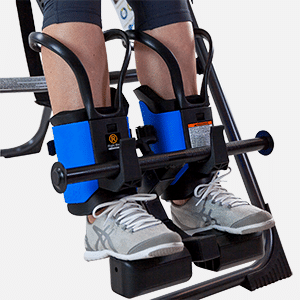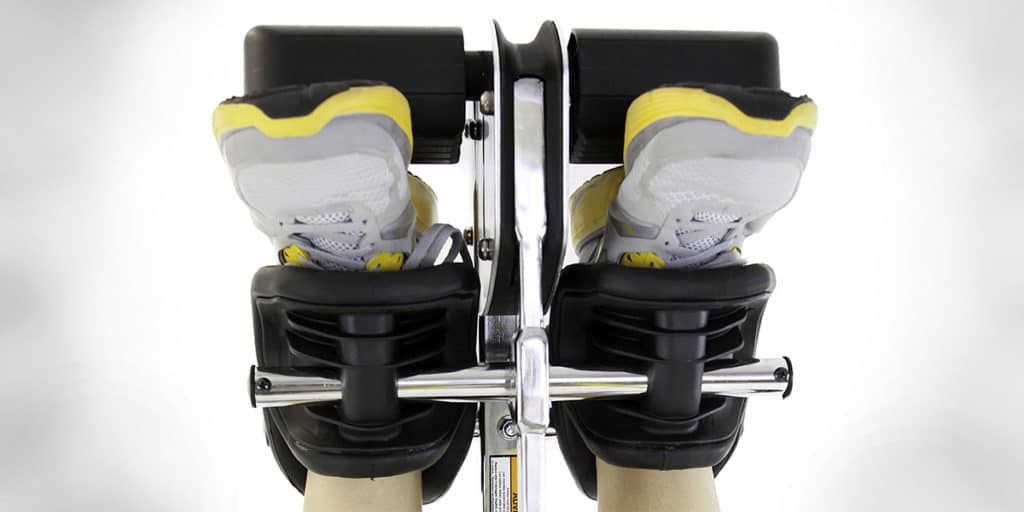While inverting can be one of the most relaxing things you do all day, some people do experience mild ankle discomfort when they are inverting. But don’t worry – there are several things you can do to improve ankle comfort so you can get the full enjoyment out of your Teeter Inversion experience.
First thing’s first: Make sure you follow the Owner’s Manual to learn the steps to properly securing your ankles. Then follow the steps outlined below:
Wear socks and lace-up shoes.
Yes, we know that sometimes lacing those puppies up can be a pain, but we recommend this from a safety perspective – and because the shoes and socks provide a good cushion to support your ankles as you invert.
Fit your body type.
To minimize body slide on the Table Bed while inverted (which can cause a shift in weight distribution and interfere with the ease of which you can control your rotation), find your ideal Ankle Comfort Dial setting. It easily rotates to a lower or higher position, with a one-inch height variance. Select the position that allows the Front & Rear Ankle Cups to secure around the smallest part of your ankles (with minimal distance between the Ankle Lock System and the top of your foot).
Adjust the cups.
As you invert and your body shifts slightly, the Rear Ankle Cups will naturally rotate up. So rotating them slightly downward before mounting is key – this will allow them to rotate and cup the back of your ankles comfortably. This seems like a small adjustment, but can make a huge difference!
Check your fit.
The ankle lock system doesn’t have to be clamped down so hard that you are cutting off circulation. Simply use this standard to achieve a comfortable fit: the Front & Rear Ankle Cups should be snug and close-fitting around the smallest part of your ankles. Be sure to follow the ‘Hear, Feel, See, Test’ method described in the Owner’s Manual!
Adjust your angle.
Are you inverting too far, too soon? Perhaps even all the way to 90 degrees (full inversion)? If so, try easing off and inverting to only about 30-45 degrees for a while. Being inverted takes training, just like any other fitness activity. Your body can quickly adapt to changes, but try increasing angles gradually over time – your ankles will thank you.
Adjust your method.
Did you know there are a couple of different ways to invert? There is static inversion (just hanging there), intermittent (alternating inversion with resting at horizontal), and oscillating inversion (rhythmically moving up and down). If you are usually inverting statically, try using slow arm movements to experiment with intermittent or oscillating inversion. As you move from horizontal to inverted, you give your ankles a break while still experiencing the benefits of inversion.
In this short video, Rylie Teeter shows you some simple things you can do to improve ankle comfort while inverted.
Want More Ankle Comfort for Your Teeter?

If you are still having ankle problems while you invert and you’ve tried all of these suggestions, it may be time to think about upgrading your equipment.
While most people find these tips can help reduce ankle pain, other people opt to use the EZ-Up Gravity Boots with Adapter Kit with their inversion table. Or for those with larger ankles, the EZ-Up Gravity Boots XL with Adapter Kit are 1″ larger in diameter and 1 1/2″ taller than the standard EZ-Up Gravity Boots which are one-size-fits-most.
The Gravity Boots provide extra surface area to distribute your weight. They are especially helpful if you enjoy full inversion for periods longer than five minutes or want to use your Teeter as an exercise station!
Order Your EZ-Up Gravity Boots
Now you can try the Teeter EZ-Up Gravity Boots FREE for 30-Days, 0% APR* with Affirm.
